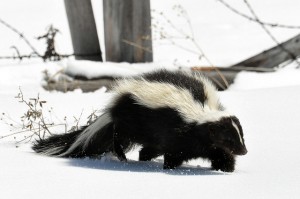Skunks Description and Habitats
The skunk is 20” to 30” long including a 10” to 15” tail weighing 6 to 12 lbs. There coat is thick, fluffy, mainly black with a large white nape patch that continues and becomes two stripes along sides of back, usually reaching the tail (occasionally mostly white above). They typically will have a narrow white forehead stripe. Their head is pointed having small ears and eyes. Their legs are short and their tail is long and very bushy. Skunks sleep deeply for up to 3 ½ months at a time but are not true hibernators. They’ll emerge periodically during warm spells and during the mating season. Skunks den alone, or in a group of 2–7 females and 1 male. They do not migrate. The skunk typically breeds from late February to March having young May through June. Their typical litter size is 4 to 7 skunks. Skunks will eat insects, rodents, bird and turtle eggs, fruit, roadkills and garbage.
Caution: If threatened it raises it’s tail, backs up and may stomp ground; may very quickly emit foulsmelling, sulphurous spray that travels up to 16′, stings eyes of predators, pets, humans.
If you or your pet is sprayed, create a paste out of 1 quart of hydrogen peroxide, ¼ cup of baking soda and 1 teaspoon of liquid soap and immediately wash you, your pet and soak your closing.
Skunks Damage and the Health Hazards
Skunks are opportunists seeking food and shelter. We typically see them when they are seeking a sheltered place to raise their young. They may den under porches, decks foundations, garages, barns or sheds. There typical nuisance activities include digging in lawns for grubs and spraying your domesticated animal with it’s horrific smelling defense spray. Although cute and typically harmless, skunks are a vector species, meaning they are a carrier of rabies. Skunks may also carry distemper. As with all wildlife, human contact should be avoided and left to a professional.
If there is one recommendation Wildlife Busters can make, it is to never block an entry way to stop the skunks. If you have blocked a skunks active travel path and are not 100% certain that the den is vacant then you open yourself up to a whole new set of problems.
It is possible that a skunk or skunks become trapped and if they cannot dig another way out they will certainly die under your property or affected structure. When a skunk does become deceased the muscles that, holds in the oil, which produces the dramatic odor, releases allowing the oil to leak out and cause a constant and overpowering smell from the skunk. Understanding that skunks burrow very deeply and out of reach of predators and animal control officers justifies the difficulties that might follow for dead skunk removal. Our animal damage repair and decontamination/deodorizing services will help but the source of the odor almost always needs to be found and removed.
Skunk Removal Services
At Wildlife Busters we believe that prevention is always the best policy when it comes to dealing with nuisance wildlife. Proper repairs to a commercial or residential building, maintenance plans and inspectional services are just a part of what might help you avoid having to deal with a wildlife removal issue. Some helpful tips include:
- Treat your lawn to reduce the grub population.
- Don’t leave pet food or their food bowls outside.
- Put the trash out in the morning.
- Skunk proof your garbage cans.
- Close garage doors at night.
- Cover window wells.
- Trench prevention around sheds, decks, barns etc.
Wildlife Busters provides humane services for skunk trapping and removal services as well as prevention services that ensure the skunk does not return.
Photo by By NDomer73

 Receive FREE wildlife Tips!
Receive FREE wildlife Tips!

